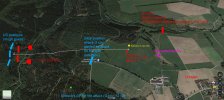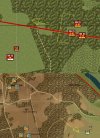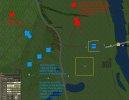I answer the question, and you want to find something to contradict it?
Well, it looks like ghibli kept some bits and pieces of an old discussion in mind, and all he did was to chip in that rough recollection.
Ghibli might have had this statement from Dave in mind:
I just did a bit of a search of the code and can confirm that yes we did turn off the range attenuation. I also have to admit that my comments in the code are not really that helpful in explaining why. The attenuation code was embedded in another function that was replaced holus bolus. Let me ponder this for a bit. Good catch.
And Dave's following statement:
Did some more investigating. I believe the thinking at the time when it was removed was that the time it took to send orders by radio made distance irrelevant given the normal size of our battlefields. The concept of a command range is more relevant when physical contact is required for the transmission of orders. Now I know that this did occur but did so more at the outset of a battle not during it. Moreover commanders and their liaison officers would often go to the subordinate HQ to deliver the order. We don't model these individual commanders and liaison officers.
My feeling on the issue right now is that applying a range modifier to the orders delay would be valid in only a few cases of all the orders sent. Trying to come up with an algorithm as to when that should occur is going to be difficult. Applying the modifier all the time is probably an unjust impost on all orders. Applying it on a random basis would just frustrate players. So on balance I think we should just leave it as is.
So, not the command range code itself, but the code that enabled range attenuation was removed completely.
What Dave et al didn't mention/discuss, is that if you consider/use attenuation then terrain features (eg. mountain ranges) and historic radio ranges should be considered as well, if you want to make radio communication realistic/historically accurate.
That's a bit more complex - not just programming-wise, because it would also involve quite some research work to gather sufficient infos about the radio equipment used at the various command levels and in vehicles and command vehicle models.
For instance, for long range transmissions from field CPs (generally above Bn level, but partly starting with Bn level) the Germans, the Western Allies and (I guess) the Russians used trucks with tall radio masts, but mobile frontline units like armored cars or tanks were quite limited regarding radio range, and large antennas for line units not used/considered, for several reasons (detectability, vulnerability,etc.). For such units, a set of mountain ranges or a set of woods could effectively block all radio communications in the area.
The Germans equipped radio vehicles (ranging from armored recon cars with 6- and 8-wheels, scout cars to halftracks) and command vehicles (cars, tanks, halftracks) with the more powerful frame antennas and equipped a number of their armored recon cars that served in Recon Bns and the armored cars and halftracks of artillery observer elements with retractable periscopes/telescopes and retractable radio antenna masts (up to 8-10 meters tall, iirc) to increase max range and to address difficult terrain conditions, so that they could relay the gathered information.
EDIT: The Russians and the Germans used frame antennas on light tanks, the Russians even put them on medium command tanks, like the command version of the T-28. Both nations removed frame antennas from tanks gradually, as such outfits used to draw more fire, because the frame antennas gave away the fact that those particular tanks sheltered unit commanders, but they kept these antennas on a number of other vehicle types. The replacements were whip antennas, which in the Panzer III could be retracted (into the rear end of the crew compartment), to avoid damages during artillery bombardments or close combat infantry attacks, for instance.
I am guessing that radio calls/reception were/was restricted to the immediate vicinity, once the antenna was retracted.
But with the regular equipment used at the time, say tank units would lose radio (voice com) contact with superior units after some say 8-10 km, iirc, and somewhat more powerful radios offered voice com ranges of say 9-12 or even 15 km (iirc) at later stages of the war. US units had an advantage in 1944, as their equipment increasingly contained transistor technology, which allowed for smaller devices (not necessarily better ranges), so that more units could be equipped with medium range equipment. I am guessing that they shared the tech with the Brits, as I recall that the Brits even used walkie talkies and their bigger "brothers" in UK's civil defense units. The somewhat higher voice com max. ranges could usually only be reached with the extra equipment put in a Befehlswagen (command tank of a Coy or Bn), where then in quite a few tank models the main gun had to be removed, to make room for the larger 2nd transmitter and an extra receiver, etc.
I outlined the exact ranges of tanks, recon cars, inf artillery FW observers and platoons/coys in a thread years ago, in a discussion about communication and broken comm. lines, where I then suggested to implement historical radio ranges.
Cut off units, say a tank coy, either had to use/stick to predefined orders, or they had to develop their own plans/initiatives and then wait for friendly units to catch up, once they lost radio contact.
The radios in Command tanks had the equipment to send morse codes, usually, which then offered ranges of up to 20-30 km iirc, and even the regular radios in regular tanks had morse ranges of around 15-20 km in theory, depending on the transmitter model, but morse telegraphy was slow and cumbersome and the radio operator was also needed as MG gunner. The low transmission speed also made it easier for the enemy to intercept messages.
If orders allowed to back away, such units could also just go back to a sector where radio contact could be re-established. Sometimes this just involved placing a command tank or radio car/falftrack on the obstacle (eg. mountain range) or a short relocation to a more favorable position to re-establish comms.
While I'd love to see this rendered in the game, it'd be a rather complex project that would just delay programming work on more important features (dismount feature


)


